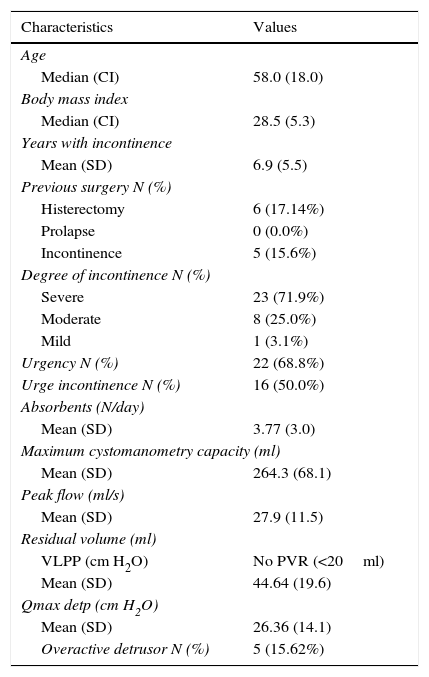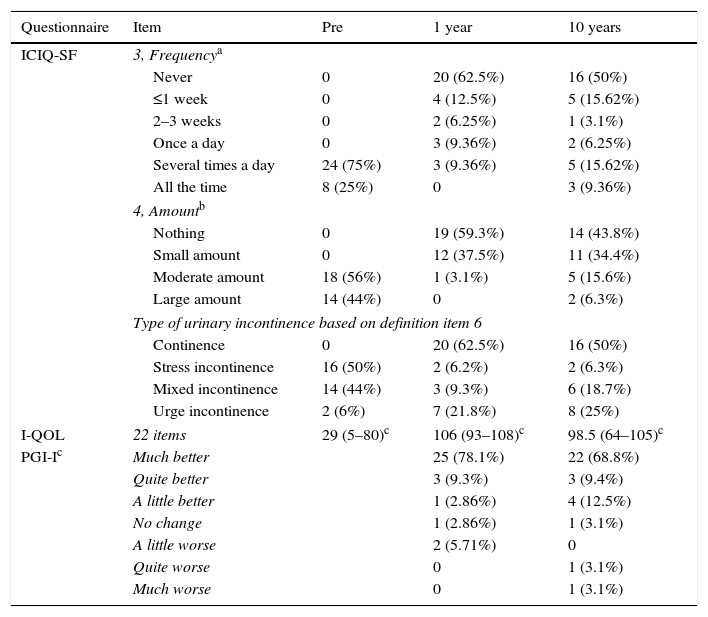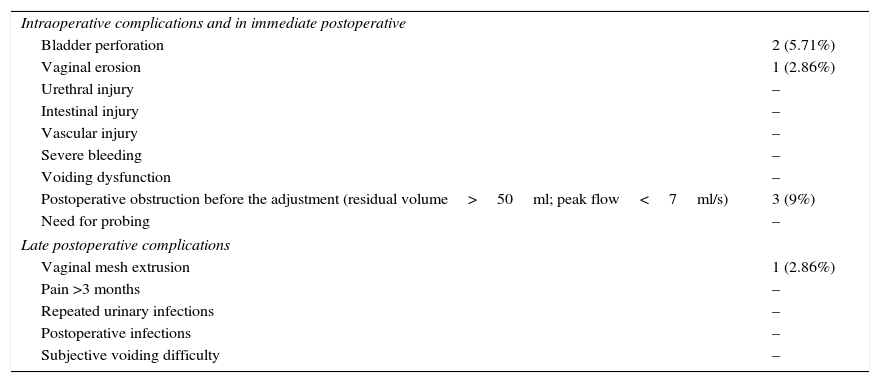To assess the long-term safety and efficacy of the adjustable TVA mesh in treating stress urinary incontinence.
Material and methodsPseudoexperimental study, before and after, conducted in a university urology department.
Eighty-two patients were invited to participate from January 2002 to March 2005. Thirty-two patients agreed to participate and were implanted an adjustable TVA mesh. The preoperative study included a medical history review, physical examination with full bladder, flowmetry, residue study, complete urodynamic study and the self-administered questionnaires I-QoL and ICIQ-SF.
In the postoperative assessment, the PGI-I questionnaire was added, but a complete urodynamic study was not performed.
ResultsTwenty-nine (90.6%) and 28 (87.5%) patients were continent in the stress test at 1 and 10 years, respectively. Twenty (62.5%) and 16 (50%) patients had no urine escape at 1 and 10 years, respectively. Twenty-eight (87.5%) and 25 (78%) patients were satisfied 1 and 10 years after the surgery, respectively. Twenty-eight (87.5%) and 21 (62.5%) patients had a good quality of life at 1 year and at 10 years, respectively. There were no significant complications at the end of the study period.
ConclusionsTreatment of stress urinary incontinence with the TVA mesh presented a high degree of objective healing and satisfaction at 10 years, with no severe adverse effects. The study showed that satisfaction does not always mean total continence but rather it reflects the improvement of symptoms and consequent quality of life.
Valorar a largo plazo la eficacia y seguridad de la malla ajustable TVA en el tratamiento de la incontinencia urinaria de esfuerzo.
Material y métodosEstudio seudoexperimental, antes y después, realizado en un servicio universitario de urología.
Ochenta y dos pacientes fueron invitadas a participar desde enero de 2002 a marzo de 2005. Treinta y dos accedieron a participar y se les implantó una malla ajustable TVA. El estudio preoperatorio incluyó historia médica, examen físico con vejiga llena, flujometría, residuo, estudio urodinámico completo y los cuestionarios autoadministrados I-QoL, ICIQ-SF.
En la evaluación postoperatoria se añadió el cuestionario PGI-I, no realizándose el estudio urodinámico completo.
ResultadosVeintinueve pacientes (90,6%) eran continentes en la prueba de esfuerzo al año. Veintiocho (87,5%) a los diez años. Veinte pacientes (62,5%) nunca tenían escape al año. Dieciséis (50%) a los diez años. Veintiocho pacientes (87,5%) estaban satisfechos al año de la cirugía. Veinticinco (78%) a los diez años. Veintiocho (87,5%) tenían buena calidad de vida al año y veintiuno (62,5%) a los diez años. No hubo complicaciones importantes al final del periodo de estudio.
ConclusionesEl tratamiento de la incontinencia urinaria de esfuerzo con malla TVA presenta un alto grado de cura objetiva y satisfacción a los diez años, sin efectos adversos graves. El estudio muestra que la satisfacción no siempre significa continencia total sino que expresa la mejoría de los síntomas y la consiguiente calidad de vida.
Artículo
Comprando el artículo el PDF del mismo podrá ser descargado
Precio 19,34 €
Comprar ahora











